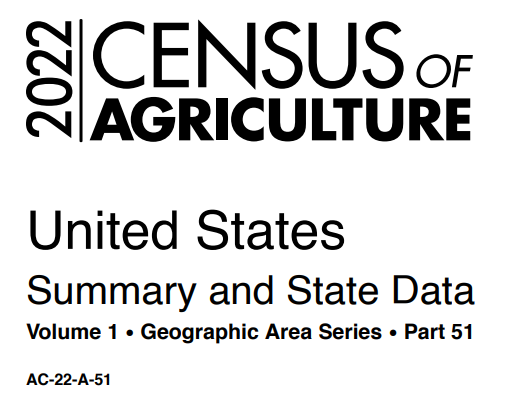Stay up to date on the county

Stay up to date on the county
SHELLEY’S SHARE: “Anne Arundel County Agriculture By The Numbers”
February 16, 2024
On February 13, the USDA released the 2022 Agricultural Census. The typical process for the Census is landowners receive a survey asking for gross revenue and expenses, and information on their farm make up such as acreage and products and their animal numbers. It’s redone every five years and this Census has been much awaited. I, myself, thought that we’d see a pretty large increase in certain agricultural areas. Not so much the acreage retention, since we know we have a loss of farmland, but in animal numbers and diversity in operations. The large push for additional income to the farm through agritourism and value-added product sales made me think we’d see some upticks.
There were a few things I found pretty notable.
For starters, our number of farms rose. In 2017’s Census we had 391 farms, and in 2022 we’ve come up to 454. Now, I will say that within my years at Soil Conservation, I know that there are more than 454 farms out there. We had three cabinets that were stocked full of farm plans, four drawers deep each. I think when I left we were into the 1300’s on farm numbers from the Farm Service Agency, keeping in mind that some of the earlier numbered farms have since been sold and subdivided or lay fallow now. I’d say that our farm numbers are still healthier than the Census represents. Our average size farm also increased from 69 acres to 79, with the median being up from 24 to 25. Not a huge change, but we’ll take it. I’m hopeful this is proof that our economic programs and legislative changes are helping the farms become and remain viable.
 What I didn’t expect to see was the number of preserved farms go from 54 to 52. Without context from the agricultural preservation department, my initial reading of these numbers sends a bit of panic into my farming veins. Two thoughts come to mind when I read these numbers: 1—the obvious: we lost two farms from preservation. Why and how did we lose two farms out of the preservation programs? What wasn’t working in the program to not have them re-enrolled or to enroll in a perpetual program? And 2—did we really not add any preserved farms from 2017-2022? I hope that’s not the case, and in my direct relation to the agricultural community I do know that a half a handful did enroll their farms during that time period.
What I didn’t expect to see was the number of preserved farms go from 54 to 52. Without context from the agricultural preservation department, my initial reading of these numbers sends a bit of panic into my farming veins. Two thoughts come to mind when I read these numbers: 1—the obvious: we lost two farms from preservation. Why and how did we lose two farms out of the preservation programs? What wasn’t working in the program to not have them re-enrolled or to enroll in a perpetual program? And 2—did we really not add any preserved farms from 2017-2022? I hope that’s not the case, and in my direct relation to the agricultural community I do know that a half a handful did enroll their farms during that time period.
Another change in the Census came to the average age of producers. Do you know what the average age of the Anne Arundel County farmer is? 57– “down” from 58 in 2017. Here’s what that average age says to me: that as those farmers start to retire, we need backup producers to step up. The Census shows that the next age group of 35-44 is only numbered at 93. 93 producers do not replace the 267 that are reflected in the reported 57 average age group. Now, we all know that farmers never really retire. They just say they’re going to retire over and over again. It’s in their blood and they’ll never truly give it up. I’d estimate that age to realistically happen around age 102. So, hopefully, we’re ok on the number of producers for now. But looking deeper at producers under the age of 25, we only have a reported 28. By the time we move to that generation being the prime producers for Anne Arundel County, who’s going to fill their shoes and how will they get all of the farming done?
The equine reporting also stuck out to me. As an equestrian myself, it was natural that I went to those statistics pretty quickly. The 2017 Census reported we had 1,525 horses. 2022 reports that we have 1,450 horses. I find those numbers low relative to the number of horses I know exist in our County. I did a rough and conservative estimate on the number of horses I know are in just southern Anne Arundel County, and I came up with just over 1200. That’s not counting the northern portion of the County which boasts its own healthy stock of equines. With the number of cropland sold off over the past years I expected the number to increase for horses. I feel that when farms sell, it either goes to houses or horses. It was a bit surprising and I was more hopeful for a higher number from the only official statistical document we get to reference for agriculture.
There are more differences in the Census than I can cover in one share, but in my few short days of having access to the document these are only a few of the flags I see. So, based on what I’ve seen so far, what can we do to ensure agriculture is preserved in the area for generations to come?
I think it boils down to three goals.
The first is actually reporting. We can’t get accurate statistics without producers reporting what they’re doing. This is only a snapshot of those who filled out the Census. The number of farms I’ve stepped on versus the number reflected in the report proves that. Yes, it’s annoying and feels a bit obtrusive and mundane to have to provide your operations data. But it’s imperative to do it so we have accurate representation of our County’s agriculture. How do we lobby for more agricultural support without having the true numbers? It certainly doesn’t help the cause when we have to give a caveat of “the numbers say this, but I know it’s closer to this…”.
 The second goal would be to increase access to agriculture education. With only 28 producers to replace our current generations of farmers, it has to start in their education to build the interest. Kids spend the majority of their time until 18 in school. That’s the gateway to hooking the younger generations. The only two public schools that host agricultural programs are Southern High School and CAT North. There are 126 public schools in Anne Arundel County. Sounds to me like there’s major opportunity missed in our school systems. And for reference: there’s no longer principal to principal transfers within the County to allow students not in an agriculture education school to change to a school with the pathway. Why are we holding them back? Why are we not finding a way to make it happen for our students?
The second goal would be to increase access to agriculture education. With only 28 producers to replace our current generations of farmers, it has to start in their education to build the interest. Kids spend the majority of their time until 18 in school. That’s the gateway to hooking the younger generations. The only two public schools that host agricultural programs are Southern High School and CAT North. There are 126 public schools in Anne Arundel County. Sounds to me like there’s major opportunity missed in our school systems. And for reference: there’s no longer principal to principal transfers within the County to allow students not in an agriculture education school to change to a school with the pathway. Why are we holding them back? Why are we not finding a way to make it happen for our students?
And lastly, agriculture preservation. The agriculture preservation program requirements may need adjusting to cover the changing farm sizes in our County. The Census reports that only 113 of our 454 farms are over 50 acres. The preservation program requires a minimum of 50 acres. You’ve ruled out most farms based on just that one requirement. There’s not many generational transfers of farms now. Many kids leave the farm and when they inherit the land they don’t know what to do with that much property and it gets sold to a developer and another farm bites the dust. Preservation can help alleviate the loss of farmland, but as everything else has to, it needs to evolve its expectations to meet today’s reality.
These are just snapshots of the data represented in the 2022 USDA Census. Don’t like the results? Report.
My ArundelBiz Podcast Featuring Levonye Professionals »Press Contact
For all media inquiries, please contact:
Victoria Zelefsky
P 410-222-7410
E [email protected]